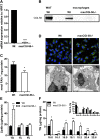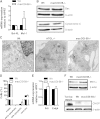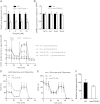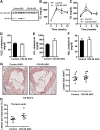Deletion of CGI-58 or adipose triglyceride lipase differently affects macrophage function and atherosclerosis
- PMID: 25316883
- PMCID: PMC4242449
- DOI: 10.1194/jlr.M052613
Deletion of CGI-58 or adipose triglyceride lipase differently affects macrophage function and atherosclerosis
Abstract
Cellular TG stores are efficiently hydrolyzed by adipose TG lipase (ATGL). Its coactivator comparative gene identification-58 (CGI-58) strongly increases ATGL-mediated TG catabolism in cell culture experiments. To investigate the consequences of CGI-58 deficiency in murine macrophages, we generated mice with a targeted deletion of CGI-58 in myeloid cells (macCGI-58(-/-) mice). CGI-58(-/-) macrophages accumulate intracellular TG-rich lipid droplets and have decreased phagocytic capacity, comparable to ATGL(-/-) macrophages. In contrast to ATGL(-/-) macrophages, however, CGI-58(-/-) macrophages have intact mitochondria and show no indications of mitochondrial apoptosis and endoplasmic reticulum stress, suggesting that TG accumulation per se lacks a significant role in processes leading to mitochondrial dysfunction. Another notable difference is the fact that CGI-58(-/-) macrophages adopt an M1-like phenotype in vitro. Finally, we investigated atherosclerosis susceptibility in macCGI-58/ApoE-double KO (DKO) animals. In response to high-fat/high-cholesterol diet feeding, DKO animals showed comparable plaque formation as observed in ApoE(-/-) mice. In agreement, antisense oligonucleotide-mediated knockdown of CGI-58 in LDL receptor(-/-) mice did not alter atherosclerosis burden in the aortic root. These results suggest that macrophage function and atherosclerosis susceptibility differ fundamentally in these two animal models with disturbed TG catabolism, showing a more severe phenotype by ATGL deficiency.
Keywords: comparative gene identification-58; inflammation; lipid droplets; storage diseases.
Copyright © 2014 by the American Society for Biochemistry and Molecular Biology, Inc.
Figures








Similar articles
-
Transgenic CGI-58 expression in macrophages alleviates the atherosclerotic lesion development in ApoE knockout mice.Biochim Biophys Acta. 2014 Dec;1841(12):1683-90. doi: 10.1016/j.bbalip.2014.08.014. Biochim Biophys Acta. 2014. PMID: 25178844
-
Functional cardiac lipolysis in mice critically depends on comparative gene identification-58.J Biol Chem. 2013 Apr 5;288(14):9892-9904. doi: 10.1074/jbc.M112.420620. Epub 2013 Feb 14. J Biol Chem. 2013. PMID: 23413028 Free PMC article.
-
The hepatitis C virus core protein inhibits adipose triglyceride lipase (ATGL)-mediated lipid mobilization and enhances the ATGL interaction with comparative gene identification 58 (CGI-58) and lipid droplets.J Biol Chem. 2014 Dec 26;289(52):35770-80. doi: 10.1074/jbc.M114.587816. Epub 2014 Nov 7. J Biol Chem. 2014. PMID: 25381252 Free PMC article.
-
Critical roles for α/β hydrolase domain 5 (ABHD5)/comparative gene identification-58 (CGI-58) at the lipid droplet interface and beyond.Biochim Biophys Acta Mol Cell Biol Lipids. 2017 Oct;1862(10 Pt B):1233-1241. doi: 10.1016/j.bbalip.2017.07.016. Epub 2017 Aug 4. Biochim Biophys Acta Mol Cell Biol Lipids. 2017. PMID: 28827091 Free PMC article. Review.
-
Comparative gene identification-58/α/β hydrolase domain 5: more than just an adipose triglyceride lipase activator?Curr Opin Lipidol. 2014 Apr;25(2):102-9. doi: 10.1097/MOL.0000000000000058. Curr Opin Lipidol. 2014. PMID: 24565921 Free PMC article. Review.
Cited by
-
Monoglyceride lipase deficiency modulates endocannabinoid signaling and improves plaque stability in ApoE-knockout mice.Atherosclerosis. 2016 Jan;244:9-21. doi: 10.1016/j.atherosclerosis.2015.10.109. Epub 2015 Nov 2. Atherosclerosis. 2016. PMID: 26584135 Free PMC article.
-
Metformin protects against oxidized low density lipoprotein-induced macrophage apoptosis and inhibits lipid uptake.Exp Ther Med. 2018 Mar;15(3):2485-2491. doi: 10.3892/etm.2018.5704. Epub 2018 Jan 5. Exp Ther Med. 2018. PMID: 29456653 Free PMC article.
-
Regulation of Hepatic Triacylglycerol Metabolism by CGI-58 Does Not Require ATGL Co-activation.Cell Rep. 2016 Jul 26;16(4):939-949. doi: 10.1016/j.celrep.2016.06.049. Epub 2016 Jul 7. Cell Rep. 2016. PMID: 27396333 Free PMC article.
-
Triglyceride breakdown from lipid droplets regulates the inflammatory response in macrophages.Proc Natl Acad Sci U S A. 2022 Mar 22;119(12):e2114739119. doi: 10.1073/pnas.2114739119. Epub 2022 Mar 18. Proc Natl Acad Sci U S A. 2022. PMID: 35302892 Free PMC article.
-
Muscle-specific deletion of comparative gene identification-58 (CGI-58) causes muscle steatosis but improves insulin sensitivity in male mice.Endocrinology. 2015 May;156(5):1648-58. doi: 10.1210/en.2014-1892. Epub 2015 Mar 9. Endocrinology. 2015. PMID: 25751639 Free PMC article.
References
-
- McLaren J. E., Michael D. R., Ashlin T. G., Ramji D. P. 2011. Cytokines, macrophage lipid metabolism and foam cells: implications for cardiovascular disease therapy. Prog. Lipid Res. 50: 331–347. - PubMed
-
- Lass A., Zimmermann R., Haemmerle G., Riederer M., Schoiswohl G., Schweiger M., Kienesberger P., Strauss J. G., Gorkiewicz G., Zechner R. 2006. Adipose triglyceride lipase-mediated lipolysis of cellular fat stores is activated by CGI-58 and defective in Chanarin-Dorfman syndrome. Cell Metab. 3: 309–319. - PubMed
-
- Schweiger M., Lass A., Zimmermann R., Eichmann T. O., Zechner R. 2009. Neutral lipid storage disease: genetic disorders caused by mutations in adipose triglyceride lipase/PNPLA2 or CGI-58/ABHD5. Am. J. Physiol. Endocrinol. Metab. 297: E289–E296. - PubMed
-
- Radner F. P., Streith I. E., Schoiswohl G., Schweiger M., Kumari M., Eichmann T. O., Rechberger G., Koefeler H. C., Eder S., Schauer S., et al. 2010. Growth retardation, impaired triacylglycerol catabolism, hepatic steatosis, and lethal skin barrier defect in mice lacking comparative gene identification-58 (CGI-58). J. Biol. Chem. 285: 7300–7311. - PMC - PubMed
Publication types
MeSH terms
Substances
Grants and funding
LinkOut - more resources
Full Text Sources
Other Literature Sources
Medical
Molecular Biology Databases
Research Materials
Miscellaneous

